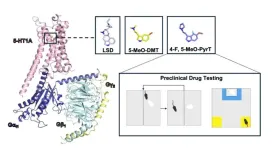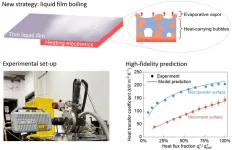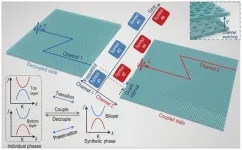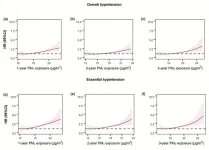(Press-News.org) Researchers at the Icahn School of Medicine at Mount Sinai have shed valuable light on the complex mechanisms by which a class of psychedelic drugs binds to and activates serotonin receptors to produce potential therapeutic effects in patients with neuropsychiatric disorders such as depression and anxiety. In a study published May 8 in Nature, the team reported that certain psychedelic drugs interact with an underappreciated member of the serotonin receptor family in the brain known as 5-HT1A to produce therapeutic benefits in animal models.
“Psychedelics like LSD and psilocybin have entered clinical trials with promising early results, though we still don’t understand how they engage different molecular targets in the brain to trigger their therapeutic effects,” says first author Audrey Warren, a PhD candidate in the Graduate School of Biomedical Sciences at Icahn Mount Sinai “Our study highlights, for the first time, how serotonin receptors like 5-HT1A likely modulate the subjective effects of the psychedelic experience and also play a potentially pivotal role in their clinically observed therapeutic outcome.”
LSD and 5-MeO-DMT, a psychedelic found in the secretions of the Colorado River Toad, are known to mediate their hallucinogenic effects through the serotonin receptor 5-HT2A, though these drugs also activate 5-HT1A, a validated therapeutic target for treating depression and anxiety. Working closely with co-author Dalibor Sames, PhD, Professor in the Department of Chemistry at Columbia University, the team synthesized and tested 5-MeO-DMT derivatives in cell signaling assays and cryo-electron microscopy to identify the chemical components most likely to cause a drug to preferentially activate 5-HT1A over 5-HT2A. That exercise led to the discovery that a compound termed 4-F, 5-MeO-PyrT was the most 5-HT1A-selective compound in this series. Lyonna Parise, PhD, an instructor in the lab of Scott Russo, PhD, Director of the Center for Affective Neuroscience and the Brain and Body Research Center at Icahn Mount Sinai, then tested that lead compound in a mouse model of depression and showed that 4-F, 5-MeO-PyrT had antidepressant-like effects that are effectively mediated by 5-HT1A.
“We were able to fine-tune the 5-MeO-DMT/serotonin scaffold to obtain the maximum activity at the 5-HT1A interface and minimal activity at 5-HT2A,” explains senior author Daniel Wacker, PhD, Assistant Professor of Pharmacological Sciences and Neuroscience at Icahn Mount Sinai. “Our findings suggest that receptors other than 5-HT2A not only modulate behavioral effects stemming from psychedelics, but may substantially contribute to their therapeutic potential. In fact, we were pleasantly surprised by the strength of that contribution to 5-MeO-DMT, which is currently being tested in several clinical trials for depression. We believe our study will lead to a better understanding of the complex pharmacology of psychedelics that involve many receptor types.”
Indeed, researchers are hopeful based on their breakthrough findings that it may soon be possible to design novel psychedelic-derived medications that don’t possess the hallucinogenic properties of current drugs. Raising their expectations is the discovery that their lead compound – the most 5-HT1A-selective analog to 5-MeO-DMT – showed antidepressant effects without the 5-HT2A-related hallucinations.
Another near-term target for scientists is investigating the impact of 5-MeO-DMT in preclinical models of depression (given the research restrictions around psychedelic drugs, studies involving a 5-MeO-DMT derivative have been limited to animal models). “We’ve demonstrated that psychedelics have complex physiological effects that span many different receptor types,” emphasizes first author Warren, “and are now ready to build on that finding to develop improved therapeutics for a range of mental health disorders.”
Research reported in this press release was supported by the National Institute of General Medical Sciences; The National Institute of Mental Health; and the National Institute on Drug Abuse. The content is solely the responsibility of the authors and does not necessarily represent the official views of the National Institutes of Health
About the Mount Sinai Health System
Mount Sinai Health System is one of the largest academic medical systems in the New York metro area, with more than 43,000 employees working across eight hospitals, more than 400 outpatient practices, more than 600 labs, a school of nursing, and a leading school of medicine and graduate education. Mount Sinai advances health for all people, everywhere, by taking on the most complex health care challenges of our time—discovering and applying new scientific learning and knowledge; developing safer, more effective treatments; educating the next generation of medical leaders and innovators; and supporting local communities by delivering high-quality care to all who need it. Through the integration of its hospitals, labs, and schools, Mount Sinai offers comprehensive health care solutions from birth through geriatrics, leveraging innovative approaches such as artificial intelligence and informatics while keeping patients’ medical and emotional needs at the center of all treatment. The Health System includes approximately 9,000 primary and specialty care physicians and 11 free-standing joint-venture centers throughout the five boroughs of New York City, Westchester, Long Island, and Florida. Hospitals within the System are consistently ranked by Newsweek’s® “The World’s Best Smart Hospitals, Best in State Hospitals, World Best Hospitals and Best Specialty Hospitals” and by U.S. News & World Report's® “Best Hospitals” and “Best Children’s Hospitals.” The Mount Sinai Hospital is on the U.S. News & World Report® “Best Hospitals” Honor Roll for 2023-2024.For more information, visit https://www.mountsinai.org or find Mount Sinai on Facebook, Twitter and YouTube.
###
END
LOS ANGELES — Keck Medicine of USC hospitals and USC Student Health, part of Keck Medicine, received the ‘LGBTQ+ Healthcare Equality Leader’ designation in the Human Rights Campaign Foundation’s 2024 Healthcare Equality Index (HEI).
HEI is the leading national benchmarking survey of health care facility policies and practices dedicated to the equitable treatment and inclusion of LGBTQ+ patients, visitors and employees. A record 1,065 health care facilities participated in the 2024 HEI survey; ...
Psychiatrists and mental health professionals have a new standard for managing major depression, thanks to refreshed clinical guidelines published today by the Canadian Network for Mood and Anxiety Treatments (CANMAT).
The CANMAT guidelines are the most widely used clinical guidelines for depression in the world. The new version integrates the latest scientific evidence and advances in depression care since the previous guidelines were published in 2016. The update was led by researchers at the University of B.C. and the University of Toronto, alongside ...
Children who experience chronic lack of sleep from infancy may be at increased risk of developing psychosis in early adulthood, new research shows.
Researchers at the University of Birmingham examined information on nighttime sleep duration from a large cohort study of children aged between 6 months and 7 years old. They found that children who persistently slept fewer hours, throughout this time period, were more than twice as likely to develop a psychotic disorder in early adulthood, and nearly four times as likely to have a psychotic episode.
While ...
In the past decade, fires from electronic devices and batteries, from small smartphones to electrical vehicles and airplanes, have repeatedly made headlines. Enhanced computational power has led to a large amount of waste heat generation and undesirable temperature rise of electronics. Poor heat management is the cause of over half of electronic device failures. To tackle this issue, it is crucial to develop advanced cooling technologies to effectively manage heat and maintain temperatures in the working conditions.
Among various cooling technologies, liquid-vapor phase-change cooling, which utilizes the boiling or evaporation of ...
This study is led by Prof. Xu (State Key Laboratory of Integrated Optoelectronics, College of Electronic Science and Engineering, Jilin University), Prof. Yu (College of Information Science and Electronic Engineering, Zhejiang University), Prof. Han (Precision Instrument and Optoelectronics Engineering, Key Laboratory of Optoelectronic Information Technology, Tianjin University and Guangxi Key Laboratory of Optoelectronic Information Processing, School of Optoelectronic Engineering, Guilin University of Electronic Technology), and Prof. Sun ...
Hypertension is among the leading cardiovascular diseases. Despite extensive research, evidence concerning the relationship between long-term exposure to ambient particulate matter and hypertension remains limited and inconsistent, particularly with regard to submicron particulate matter (PM1). While randomized controlled trials are considered the gold standard for causal inference, environmental epidemiological studies typically rely on observational data. Traditional approaches in observational studies are less effective than randomized controlled trials in fully controlling for confounding factors to achieve results with causal interpretability. With the advancement of causal ...
Recently, Science Bulletin published a research conducted by Prof. Pingqing Fu and Dr. Libin Wu from Tianjin University, Peng Wang from Fudan University, and their Chinese and foreign collaborators. They explored the source of ammonium in PM2.5 at different heights of the atmospheric boundary layer in Beijing, and found that combustion-related ammonia is very important to ammonium in PM2.5 during haze pollution in winter.
Air pollution and treatment in Beijing have been widely concerned by both the scientific community and the public. Although its PM2.5 has decreased significantly in the past few years, there is still haze pollution in Beijing, especially in winter. The chemical compositions ...
The researchers conducted a study over four days, including overnight stays, with 18 subjects at :envihab, the DLR medical research centre in Cologne. At a simulated altitude of 2500 meters above sea level, the influence of hypoxia (oxygen deficiency) on various hemodynamic and metabolic parameters was investigated. The central venous pressure via a catheter and the blood flow in the lungs using real-time magnetic resonance imaging were evaluated. The results showed that neither the pulmonarypressure nor the blood flow changed significantly. All patients able to tolerate a longer stay at altitude of 24 to 30 hours without complications.
Oxygenation ...
The Australian brook lamprey (Mordacia praecox) is part of a group of primitive jawless fish. It’s up to 15 cm long, with rows of sharp teeth. Surprisingly, it doesn’t use these teeth to suck blood like most lamprey species – it’s non-parasitic.
As larvae, the Australian brook lamprey lives buried in the bottom of streams for around three years, filter-feeding. Its adult phase is about one year long, in which it doesn’t feed at all. Prior to this study – funded in part by the Australian Government through the National Environmental Science Program’s (NESP) Resilient Landscapes Hub – the species was widely believed to only live in a few streams ...
A unique $3.7m plant lab will put researchers on the frontline in the fight against climate change and create crops for “tomorrow’s atmosphere today”.
The new flagship facility at the University of Essex will allow scientists to adapt plants for a hotter drier planet as food security is increasingly threatened.
It boasts a cutting-edge commercially standard vertical farm, an indoor field that replicates real environments anywhere in the globe, and suites that imitate a warming world – with researchers able to raise CO2 concentration and temperature levels at will.
Computer ...








